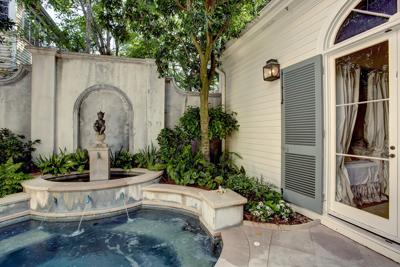During the heat of summer, my favorite places to work are in the shady areas of my landscape.
Gardeners often gripe about how difficult it is to grow plants in shade, but trouble mostly occurs when sun-loving plants are used there. When the proper plants are selected for shady areas, the results are beautiful and enduring. And now would be a great time to plant shady areas with shade-tolerant plants.
Shady areas are often created as trees grow larger over the years. At some point, the original landscape will have to be modified to deal with the reduced light conditions. Lawns often die out under trees as the trees grow and cast more shade.
One way to deal with bare ground under a tree is simply to mulch the area. Kill or remove any weeds or unwanted vegetation, then spread a 4-inch layer of leaves (use the leaves the tree drops), pine straw, bark mulch or other organic mulches. This keeps the area neat and attractive and makes the tree happy.

The leaves of shade-loving ferns (seen under the trees) may be delicately divided or bold and coarse, but the delicate ones are typically used in landscaping. Here they mix with the neon gree and purple of sweet potato plants.
??
Getting ready to plant
You may also plant shaded areas. Most shade-loving plants are native to forest floors, where the tree canopy limits the light. Leaves fall from the trees and accumulate, creating a soil high in organic matter. When preparing beds for shade-loving plants, it’s a good idea to incorporate generous amounts of organic matter into the soil.
When creating shade gardens under a tree, it is important to respect the tree's root system. If there are too many surface roots to turn the soil to prepare the planting area, consider simply mulching the area rather than planting.
It’s a good idea to use a gardening fork to loosen the soil down about eight inches. A gardening fork will damage fewer roots than a shovel or tiller. Avoid severing any roots larger than an inch in diameter.
Next, spread 2 to 4 inches of compost and work that in. Or bring in extra soil to create the bed (this helps if dealing with a lot of tree roots). Select a high-quality topsoil or garden soil rich in composted organic matter and apply no more than two to four inches. Lightly work the garden soil into the previously turned existing soil.

A variety of ground covers and shade-loving plants can add beauty to areas when lawn grass won't grow.
Choosing the right plants
The simplest option for a shady area would be to plant it entirely with a low-growing ground cover. Some of the better ground covers for large shady areas are monkey grass (Ophiopogon japonicus), holly fern, Japanese ardisia (Ardisia japonica), creeping liriope (Liriope spicata) and Asian jasmine (Trachelospermum asiaticum). Asian jasmine requires more maintenance. Since it is a running vine, it must be edged and cut back periodically to keep it looking neat and control its enthusiastic growth. Ground covers will cover exposed tree roots, which often makes it difficult to mow.
Many plants thrive in shady to partially shaded conditions (two to four hours of direct sun during the day). Indeed, gardening in a shady area provides a chance to grow a wide variety of beautiful plants. And gardens in shady areas are often easier to maintain since there are generally fewer weed problems.
For colorful bedding plants try impatiens, coleus, begonias, browallia, pentas, salvias (part shade), caladium and torenia.
Shade-tolerant perennials include ferns, hostas, ground orchid (Bletilla), strawberry begonia (Saxifraga stolonifera), walking iris (Neomarica), indigo (Indigofera kirilowii), ligularia (Farfugium), aspidistra, purple heart (Tradescantia), ajuga, acorus, acanthus, wild ginger (Asarum), cardinal flower (Lobelia), toad lily (Tricyrtis), Indian pinks (Spigelia), violets and the many tropical gingers to name a few.

Double impatiens in both red and white work well in this shade garden combined with lime green Joseph’s Coats.??
Shrubs to consider in part shade include hollies, azaleas, nandinas, cleyera, ligustrum, aucuba, fatsia, mahonia, pittosporum, hydrangea, red buckeye, sasanqua, camellia and many others.
Nurseries often have special areas where the shade-loving plants are displayed. This makes it easier to make your plant selections. Generally, any plants you see growing out in full sun at the nursery would not be good choices for your shady areas.
Learn more at the Spring Garden Show
If you would like to learn more about gardening in the shade, I’ll be presenting a lecture at the New Orleans Spring Garden Show at 1 p.m. Sunday, April 7.
The Spring Garden Show will take place April 6-7 at the New Orleans Botanical Garden on Victory Avenue in City Park. The hours are from 9 a.m. to 4 p.m. on both days. Admission is $12 for adults, $6 for children 5 to 12. Friends of City Park and children under 5 enter free. The show is sponsored by the LSU AgCenter in cooperation with the New Orleans Botanical Garden and the Metro Area Horticulture Foundation.
In addition to the diverse plant sales and garden product exhibits throughout the garden, the show includes a Children's Discovery area, educational programs, great food, arts and crafts, cooking demonstrations and more. There will be live music each day.
Educational programs take place both days in the Garden Study Center and are free with entrance to the show. The lectures are interesting and featured speakers present locally appropriate gardening information.





